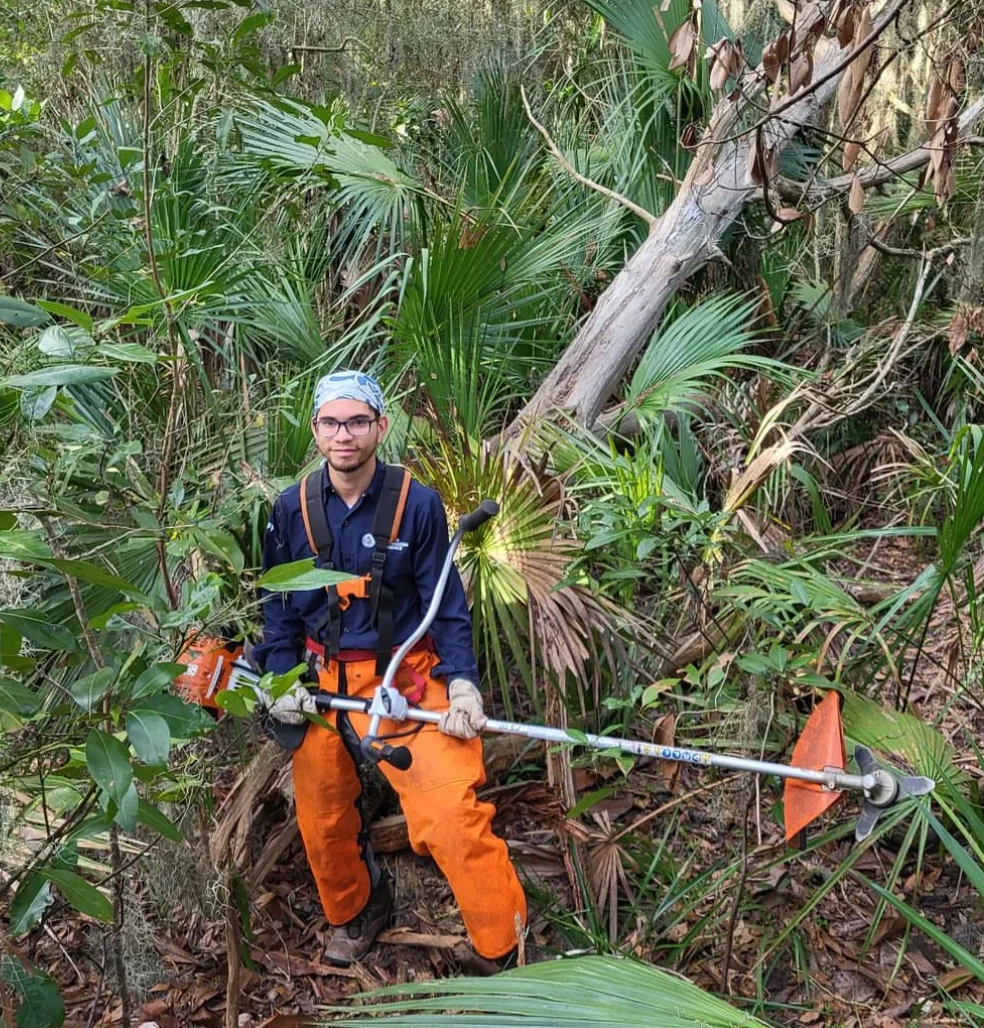Last updated: January 25, 2024
Article
Rewarding Historic Preservation Project at Camp Nelson National Monument Unlocks New Opportunities

Photo Courtesy of American Conservation Experience
Jonathan is from Florida and he joined ACE to gain practical conservation skills as well as sharpen his leadership skills as a crew leader. He previously worked as an AmeriCorps volunteer and was soon hired as an ACE staff crew lead a few months into his AmeriCorps term. He enjoyed learning and applying his skills to updating a fence at Camp Nelson National Monument because it allowed him to support the park's historic preservation mission and play a role in distinguishing the park’s identity.
How was your project experience?

Photo Courtesy of American Conservation Experience
How does it feel to be part of a project focused on preserving historical sites like Abraham Lincoln Birthplace and Camp Nelson?
It feels like I'm a part of a meaningful mission to convey important aspects of our cultural and natural history using the physical landscape. For example, our ACE crews built more than 2,300 feet of split-rail fence at Camp Nelson National Monument. Imagine when a visitor comes to visit the park now. They'll be able to walk along the grounds and see the historic structures and envision the lives of those who lived during civil war times.
I also feel a great sense of satisfaction when facilitating opportunities for my crew to learn practical skills (i.e., learning various power tools and carpentry methods while building fences) and helping young volunteers form connections to professionals employed within the National Park Service.
What specific tasks or responsibilities do you have within the project?
I'm tasked with leading ACE's crew of AmeriCorps volunteers at Camp Nelson National Monument. I primarily communicate with ACE project managers and park employees to determine the details and logistics of the fence-building in addition to removal projects. My job is to convey the project details to the ACE crew and conduct safety briefings. That includes me working alongside the crew and supervising them to ensure the work is done in a safe manner. I also teach tutorials on how to use tools and work more efficiently, while growing their skill set and knowledge. Finally, I look for learning opportunities about the park to allow them to connect with the mission and importance of their work.
How did you learn and grow?

Photo Courtesy of American Conservation Experience
In what ways has your involvement in this project contributed to your personal or professional growth?
This project helped me to become more proficient at using power tools like drills, angle grinders, sawzalls, circular saws, and others. I now know how to build split-rail fence and I've gained more leadership experience with helping a crew of more than ten people learn all these same skills. Finally, I’ve deepened my understanding of what goes into historic preservation, why it's important, and what working in the National Park Service might be like.
Can you share a memorable moment or experience you've had with your team?
I really enjoyed the days where the ACE crew and Camp Nelson National Monument staff worked together, whether working side-by-side or spending time in the Glass House to enjoy lunch together. Lots of laughs and good moments. Luke, Chris, Harrison, and Steve have all been so welcoming and hospitable to our ACE crews. They have often thanked us for our work and really let us know that we've made a lasting impact at the Camp Nelson National Monument and on the local community.
What was the impact on the community?

Photo Courtesy of American Conservation Experience
How does working on the restoration of historical fences connect with your personal values or interests?
In college, I studied anthropology. Archaeology, which is a subfield of anthropology, includes the preservation of human history through different means. Working at Camp Nelson National Monument to build historic fences felt, in a way, like my archaeology courses and field work. I especially enjoyed going into the park's visitor center's museum and seeing the collection of artifacts from the Civil War era.
Have you discovered anything surprising or particularly interesting about the history of the sites you're working on?
One aspect I found surprising about Camp Nelson National Monument history is that Black individuals who were enslaved would often enlist into the U.S. army during the Civil War to emancipate themselves. Camp Nelson was a place for these emancipated people to stay, and there were people in positions of power that helped these emancipated individuals build communities despite great public disapproval.
Do you have any closing thoughts to share about your experience?
I can honestly say that this experience has been one of the most amazing crews I've been a part of for several reasons. I had the opportunity to work alongside other ACE staff crew leaders and ACE crew members (AmeriCorps volunteers), who were all very driven. When the crew members got a full understanding of the workflow and how to use the tools, they would all place themselves in positions to keep on working efficiently by anticipating future needs. For example, there were always members who kept an eye on batteries for recharging and others who would always prepare more wooden beams to keep the fence-building process flowing. Not only were we all hard workers, but everyone brought with them a positive attitude, keeping things professional and getting along well with Camp Nelson National Monument professionals making collaboration enjoyable. As their ACE leader, I’m very proud of the work everyone delivered.
Follow along with us as we share new stories about youth-specific MAT projects in this article series. Have a question about Youth or Young Adult Programs? Please e-mail us. Learn more about what we do. Be sure to follow us on Facebook, Twitter, and Instagram.
